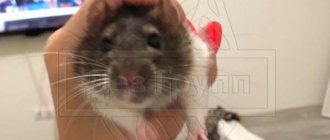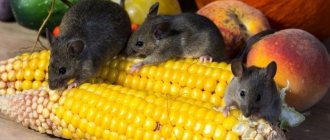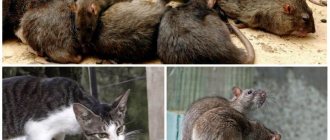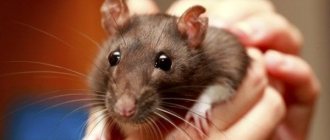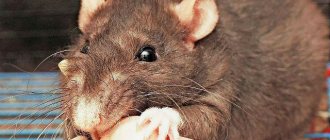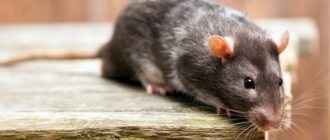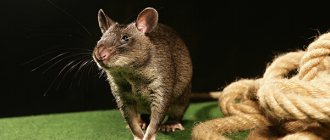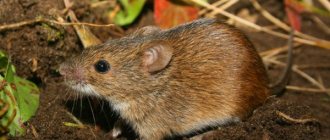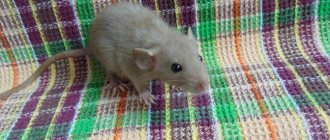- Wild animals
- >>
- Mammals
The bamboo rat is a rodent that has adapted to live underground. This is a very famous group belonging to a family with three representatives. Fur color can vary significantly between these species. These rats are related to the underground voles of the zokor type and are similar to the large zokor. Bamboo rats are rarely kept as pets, although these animals have a very original and unusual appearance.
Origin of the species and description
It is believed that true rodents originated in Asia. They first appeared in fossils in the late Paleocene and very early Eocene of Asia and North America, about 54 million years ago. These primitive animals themselves descend from a rodent-like ancestor called Anagalida, from which the lagomorphs, a group of hares, also descend.
Video: Bamboo rat
Muridae, the ancient family that gave rise to modern rats, mice, hamsters, voles and sand flies, first appeared in the late Eocene (about 34 million years ago). Modern mice appeared in the Miocene (23.8-5 million years ago) and formed in the Pliocene (5.3-1.8 million years ago).
Interesting fact: in the 18th and 19th centuries, rats came to Europe and were used as food during famines. Ratcatchers were used to exterminate rats and catch live rats that participated in rat fights, rat races and rat pits. Rat catchers also caught and caged wild rats. During this time, natural wild albino rats were selected from the litters of captive rats due to their distinctive appearance. Naturally occurring wild albino rats were first recorded in Europe in 1553.
The widespread genus of rats first appeared in the family Muridae about 3.5-5-6 million years ago. Native to the Mediterranean, Middle East, India, China, Japan and Southeast Asia (including the Philippines, New Guinea and Australia). Since its origins, the rat genus has experienced two episodes of intense speciation, one around 2.7 million years ago, and another that began around 1.2 million years ago and is likely continuing today.
Where does the bamboo rat live?
The species' distribution range extends from eastern Nepal (2000 m above sea level) through northeastern India, Bhutan, southeastern Bangladesh, Myanmar, southern China, northwestern Vietnam, Thailand and Cambodia.
Generally, bamboo rat species are recorded from around 4000 m above sea level, with some taxa being restricted to certain altitudes and elevation not being constant throughout its known range.
The main habitats of bamboo rats:
- Nepal;
- Cambodia;
- Zaire;
- Vietnam;
- India;
- Uganda;
- Ethiopia;
- Laos;
- Thailand;
- Somalia;
- Mayakka Peninsula;
- Myanmar;
- Kenya;
- Tanzania.
Attendance uncertain:
- Bangladesh;
- Butane.
The species has been recorded in a wide range of habitats, from bamboo forests to cultivated farmland and other human habitats, although it is not found in rice fields. In South Asia, it is found in temperate forests and bamboo thickets in subtropical forests, and is sometimes found at high altitudes.
It is a long-lived species with one or two young per litter. They also inhabit sandy areas with grassy vegetation. Bamboo rats dig intricate underground burrows in the form of tunnels and remain in them for a long time.
Now you know where the bamboo rat lives. Let's see what he eats.
Phylogeny
Cannabateomis
is a member of the arboreal clade Echimyidae rodents.
Its closest relatives are Dactylomia
and
Olallamys
.
These South American bamboo rats have unique traits and are grouped under the informal name "Dactylomyines".[9] Dactylomyines are sisters to Diploma
and
Santamartamis
.
All of these taxa are closely related to the genera Echimys
,
Phyllomid
,
Makalata
,
Pattonomys
, and
Toromys
.
In turn, these genera share phylogenetic similarities with the clade containing Lonchothrix
and
Mesomis
, and with
Isothrix
.[10]
| Cladogram of Echimyini at the genus level. | |
| root | |
| Phillomid | |
| Toromys (Giant Tree Rat) | |
| Olallamys | |
(Atlantic bamboo rat)
| Santamartamis (Red-crested tree rat) | |
| Mezomis | |
What does a bamboo rat eat?
Bamboo rats are mostly active in the early morning or evening, when the animals come out of the ground in search of food. They feed on a variety of underground plants, especially bamboo, as well as seeds and fruits.
The main food they consume is bamboo, from which this hidden animal takes its name. They are excellent at digging. Their diet consists not only of bamboo parts, they also feed on shrubs, young herbaceous shoots and other roots, they eat seeds and fruits.
During the day, animals rest quietly in their shelters, and at night they come to the surface to eat the above-ground parts of plants.
For example:
- plant sprouts;
- all types of leaves;
- Fallen fruits;
- different seeds.
Unlike other excavators, which simply hide in tunnels, bamboo rats quickly find food, constantly increasing the length of their burrows in areas with thick grass. As soon as they finish plucking the plant, the creature will block the tunnel from the inside with a plug of soil. This specialization in the food aspect makes it possible to obtain a reliable and constant source of food, avoiding competition.
In addition, rats can quickly hide in tunnels located at great depths. Bamboo rats often inhabit tea plantations and build burrows and tunnel systems in these areas, destroying these crops and causing irreparable damage.
These rodents are known to be excellent eaters, capable of consuming a lot of food. At night, you can hear the characteristic grumbling sound made by bamboo rats as they try to fill their stomachs with succulent shoots.
Musk kangaroo
The seventh position in the ranking of the largest rats goes to musk kangaroos. These rodents have a musky odor and a brood pouch, which is how they get their name. The animals grow up to 35 cm in length. They feed on plants and insects or worms. Musk kangaroos can easily move on the ground and climb trees. They prefer to live in the wild and build nests near bodies of water.
Lifestyle of the Ethiopian bamboo rat
Ethiopian bamboo rats are underground dwellers. They excel at digging, creating a complex system of tunnels. During the day they hide in their burrows. They come to the surface only early in the morning or at dusk.
Ethiopian bamboo rats dig holes using their claws and teeth.
With their front legs they move the excavated soil under their abdomen, and with their hind legs they throw sand back. Species of the genus Tachyoryctes dig exclusively with their claws. They bite the roots with their teeth.
During excavation, a loose pile of earth is formed, then the rat uses its snout to move and knock the entire mass back into the hole. Ethiopian bamboo rats hide their home in dense thickets of tropical and subtropical plants.
The population density of rodents is more than two and a half thousand individuals per square kilometer.
In search of edible roots, bamboo rats constantly create new passages that form a complex system of tunnels.
There are more than 50 meters of underground tunnels per rodent. Excavation of mazes is necessary to find food and create a safe shelter.
While other diggers simply hide in their burrows, bamboo rats actively feed, constantly digging new tunnels in areas with thick grass. After biting the installation, the rodent blocks the tunnel from the inside with a grounding plug.
This food specialization makes it possible to have a reliable source of food while avoiding competition. Additionally, due to the constant threat of predators, especially the Ethiopian wolf, rats can always hide in deeper tunnels.
Ethiopian bamboo rats are ambushed by Ethiopian wolves, who watch when the rodents come to the surface from a new tunnel, sometimes the predators chase the rats in their tunnel, carefully watching for their emergence to the surface.
Being very cautious animals with large incisors, Ethiopian bamboo rats are capable of defending themselves against predators and inflicting serious injuries on potential enemies.
Ethiopian bamboo rats dig holes using their claws and teeth.
Justified and unfounded fears
More recently, some 3 decades, articles appeared in Moscow newspapers about giant rats that were encountered in the Moscow metro. The articles claimed that the rats appeared on the surface, where they attacked passersby. These rats were comparable in size to dogs, and had red eyes, yellow plaque on their teeth and a wolfish grin. In other words, terrible monsters and quite aggressive.
With the advent of the Internet, videos of horrific-looking rodents have increasingly begun to appear on social networks. The Chinese presented a photo of a rat being held by its tail. It is believed to have been the largest mammal of its species, weighing several kilograms.
Thanks to the Internet, many people began to develop phobias towards this type of rodent, both justified and unfounded. Who would want to meet a giant rat on their way, and a hungry one at that? In fact, everything is not so simple and ambiguous, since there are different types of rats, and there are also animals that look like rats.
Article on the topic: Breeds of guinea pigs with photographs and names
The world's largest rats in the wild
Mice are a type of large mammal. Some mice prefer to live far from human homes, while others, on the contrary, live closer to humans.
Unrivaled for size is the giant Gentoo rat, recently discovered on the island of Papua, New Guinea.
Their body length reaches 1 m, and their tail is 30 cm. The animals have never come into contact with people, so they are not afraid of them at all. Today scientists study rodents.
Some of the largest rats in the world include several species.
Kangaroo rats
Length: up to 61 cm. Weight: up to 3 kg.
Infrared marsupial rodents are found only on the Australian continent. These unique animals move in small steps, making their forelimbs less developed than their hind limbs.
Adults grow up to 61 cm in length, and the tail reaches 25 cm in length. The weight of these individuals varies from 1 to 3 kilograms. The largest among this species is the red kangaroo, reaching a weight of 4 kilograms. There is also the rat Paturu. Weighing 3 kilograms, it reaches a body length of 60 centimeters.
They used to inhabit almost the entire continent, but now their numbers have decreased. Introduced foxes and dogs catch large rats, causing the animal population to suffer greatly.
Woolly Bosavi
Length: up to 82 cm. Weight: up to 1.5 kg.
This rodent lives around the crater of the Bosavi volcano, which dominates a vast area of Papua New Guinea, hence its name. He is also often called Papuan because of the place where he lives.
It leads a secretive lifestyle, so it was discovered by zoologists only in 2009. Its length can reach 82 centimeters and its weight is 1.5 kilograms.
The photograph shows that these rats do not look like their relatives. Currently, scientists are considering the qualification of a new species and are inclined to classify these animals as a separate genus.
Gambian hamster rat
Length: up to 90 cm. Weight: up to 1.5 kg.
This large rodent of the Independent family, including its tail, is almost 90 centimeters in length and weighs on average between 1 and 1.5 kilograms.
These giants are located south of the Sahara. They came to the United States thanks to a man. They were brought to Florida as pets, escaped and settled into their new home.
They are nocturnal, hiding in dense forests and thickets. They can be trained, and people have taught them to detect ammunition and mines. They can recognize people with tuberculosis.
Black rat
Length: up to 22 cm. Weight: up to 300 g.
It is smaller than its gray cousin, but has large ears. It weighs on average 150-300 grams, and adults grow up to 22 centimeters.
They have a long tail, partially covered with hair. It is their black coloring that gives them their species name. Like greyhounds, they are scattered throughout the planet.
There are regional subspecies that vary in weight and size. The subspecies also differs in the number of chromosomes. In Asia there are 42 of them, and in Oceania there are the smallest - 38 chromosomes.
Turkestan rat
Located in India, the Tashkent and Turkestan ranges, Central Asia, and the mountainous regions of the Tien Shan. Prefers mountains or forests with a cool climate and high humidity.
Large wild rats grow up to 25 cm, the length of the tail is about the same, shorter by only a few centimeters. The rodent's appearance is intermediate between a black rat and an ostrich.
The Turkestan rat feeds mainly on plants. In spring it eats overwintered bulbs and seeds, in summer it eats grass shoots, in autumn it eats fruits, seeds and walnuts. The animals were known to eat earthworms, chicks and eggs, shellfish and small rodents.
These rats live in the wild, some of them live in human homes and other buildings, destroying crops and causing serious damage to agriculture.
Gray rat
Length: up to 26 cm. Weight: up to 390 g.
The most common species in Russia and other parts of our planet, often called Pasyuki. Humans reach a weight of 390 grams and grow up to 26 centimeters in length.
They have spread throughout the planet, easily adapting to any conditions. They are found not only in the polar zones of Antarctica. Asia is considered their historical homeland, from where they settled throughout the planet.
Their spread was facilitated by the sea vessels on which these rodents traveled. Interestingly, among the gray woolly individuals there are individuals with black coloring.
Did you know that rats are animals with very good hearing? If not, read this article.
Gray big rat, pasyuk
This species is widespread in our country. The body length of large animals reaches 40 cm, the tail is half as long. Rodents love to settle near bodies of water. They dig holes a meter deep in loose soil to live.
This large rat causes a lot of trouble for people because it most likely spends the winter in outbuildings or human homes.
The marmot is a predator and feeds on animal and plant foods. Sometimes they attack people and pets. Bites are dangerous to health, as pests carry serious diseases.
cane rat
This animal is commonly found on the African continent. Before the discovery of the Gentoo rat, the cane rat was the leader in size and weight. Large individuals reach a length of 61 cm and a tail length of 26 cm. A large rat can weigh up to 9 kg.
In appearance, the rodent resembles a nutria: the head is large with small eyes, thick paws end in strong claws, ears are round, and the fur is hard and bristly.
The rat lives in swamps and reeds, which is where it gets its name. These animals swim well and live in burrows that they build themselves.
They feed on plants: grains, pineapples, sugar cane, cassava. This is why they are called pests in agriculture. Residents of Africa eat the meat of the cane rat and use it to prepare delicacies.
Bamboo rat
The largest species of the blind worm family. Reaches 48 cm in length, with a tail of 15 cm. Widely distributed in Thailand and Asian countries.
With their strong teeth and claws, giant rats easily build deep underground burrows in which they live. They got their name from the place where they live - bamboo thickets. Their favorite foods are bamboo stems, roots and seeds, and fruits.
Potoroo
Another kangaroo rat takes fifth place in the list of the largest similar rodents. A potoroo can reach a size of 41 cm. The tail of these animals grows up to 32 cm. The hind limbs of rodents are more developed, which allows them to move by jumping, like a kangaroo. Animals are found in Australia. They make nests for themselves in steppe and wooded areas. Potoroos feed on plants, fungi and insects.
External resemblance to other animals
It has become a tradition these days, especially with the advent of the Internet, that many people take photographs of animals that look like rats and post these photos on social networks as a kind of sensation.
Nutria
The nutria is called the water rat because of its bright orange fangs, which are similar to those of gray voles, but the nutria or otter is not related to rats. This rodent grows up to 60 cm in length and weighs from 5 to 12 kg. Unlike rats, nutria have specific anatomical features due to their semi-aquatic lifestyle: swimming webs on their hind legs and a hard, rounded tail that serves as a rudder.
This huge rodent lives in bodies of standing water along the banks of rivers, lakes and swamps. This mammal feeds on reeds, lilies and chestnuts, but will not refuse leeches and shellfish when food is scarce.
Chickens are raised on fur farms to produce valuable warm fur and meat. Recently, fur-bearing animals have been introduced as pets.
If desired, rats could include beavers, raccoons, mangroves and all other furry mammals. But we repeat once again, these animals are not even remotely related to the Hare.
Therefore, widespread tales about huge gray mutants with glowing eyes attacking people are just a figment of human imagination. Rats have nothing to do with it.
Marmot-bayrak
This animal lives in fields, in natural conditions. With the onset of winter, the animal goes into hibernation, so it is not visible in winter. It grows up to 70 cm in length and weighs up to 10 kg. As a rule, this weight is typical for autumn, when the animal begins to accumulate nutrients for the winter. They prefer to stay away from people, and in case of danger they quickly hide in shelters (burrows).
Modern human activities have adversely affected the normal life of many living creatures, including rats, but they quickly adapt to a hostile environment.
Increased radiation, abundant chemicals and the creation of genetically modified foods are triggers for changes in the structure of gene circuits responsible for the growth of living organisms.
Thus, there is a high risk that giant rats may appear these days that can threaten human life. Unfortunately, this is the price of a thoughtless approach to nature, which often leads to environmental disasters.
Most likely, the articles that appear in the press from time to time are intended to remind people what to expect if they continue to behave in this way. Nature is a rather delicate matter that does not tolerate outside interference.
Beavers
Beavers also belong to the rodent family and are found in many places, especially along small rivers where they build dams. The beaver is easily mistaken for a giant rat, both because of the shape of its mouth and body.
At the same time, the tail is characterized by a flattened shape, similar to a wide oar. It grows up to 50 cm in length and can weigh more than 30 kg. This is the second largest rat in the world.
Interesting fact! A beaver weighing almost 350 kg and up to 2.5 m long was found in North America. However, it is unknown how old the beaver was and what led to such genetic changes.
Capybara
The capybara or water viper is rightfully considered the largest rodent on the planet. These animals have a body length of 1-1.4 m and a weight of up to 65 kg. In appearance, they resemble a well-fed guinea pig, but not a rat, so it is very difficult to confuse this aquatic rodent with a giant ostrich.
Unlike rats, the capybara has a large round head with a blunt face and a massive body with short legs that have swimming membranes.
Capybaras live only in countries with warm climates: Argentina, Venezuela, Brazil, Colombia, Peru, Uruguay. Waterfowl choose the banks of large rivers as habitats, but in the absence of food, animals move overland over long distances.
Rodents eat only plant foods. Due to its large size and tasty pork-like meat, the capybara is bred in Venezuela. The mammal's skin is used to make leather products, and its fat is used in the pharmaceutical industry.
Standard
The list of the largest rats also includes representatives of the decorative species Standard. These animals can grow up to 30 cm in length. Their tail is 15 -20 cm. Domestic rodents are slightly different from their wild relatives. They love cleanliness and spend a lot of time taking care of themselves. Animals do not overeat. For them, delicacies include products from grain crops, various fruits and vegetables. Decorative rats will not refuse meat either.
